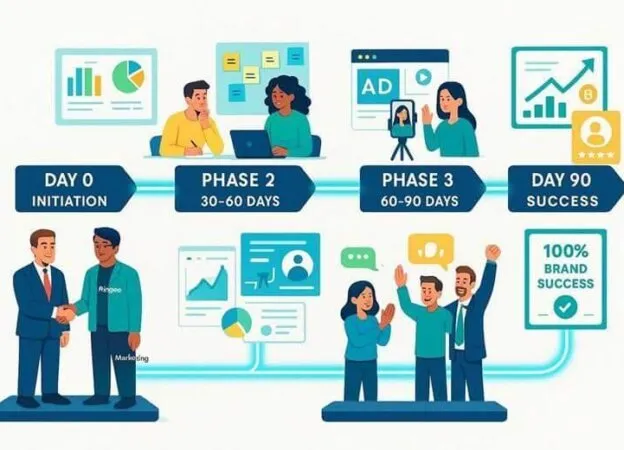Business Marketing is an ever-changing landscape—what worked five years ago might not be very relevant today.
Today, the world of marketing is highly driven by the technologies evolving every day and, of course, the way customers are evolving. Moreover, the way customers and brands interact with each other has completely changed in the last few decades.
To give you an idea about the ongoing trends in marketing, we’ve compiled the top ten business marketing strategies that dominate in 2023 and beyond.
Let’s dive right in.
1. AR and VR are on the rise
In the past, companies have used AR to create interactive retail experiences. For example, if you’re at a store and want to know what a product looks like, in person, you could use AI-powered AR technology on your phone or other devices to see how it would look on you.
The technology has influenced the world of advertising as well. Marketers can create custom content based on people’s needs and seamlessly fit the product into their daily lives via smartphone cameras.
Virtual reality creates fully immersive 3D experiences that draw consumers into new worlds—think Pokémon Go or Star Wars: Secrets of the Empire—with custom audio and visual effects that enhance the experience.
VR can be used to give customers a sneak peek at new products or services before they’re launched. It’s mainly used as part of promotion campaigns where consumers can access unique experiences while interacting with a brand.
2. Strengthen your SEO strategy
SEO is still relevant in 2023 and helps you gain an edge in any competitive space. Especially now that Google has constantly been updating its algorithm to refine the experience for its searchers, it’s more crucial than ever to invest in SEO. If you would like to find out more about SEO content writing and its cost, click here.
What’s more relevant in the world of SEO today is creating through leadership and high-quality content that provides value to its searchers and addresses their intent of looking up a search term.
In fact, SEO as a concept gets more subjective from industry to industry, and it highly depends on your go-to-market strategy. For example, if you’re creating an SEO strategy for a SaaS company, here are a few factors to keep in mind:
- Consider your sales cycle and the type of content you need to produce to support the entire cycle
- Align your go-to-market motion and SaaS SEO goals
- Cluster your ideas into topics by analyzing product-market fit and various KPIs
- Focus on creating EAT-worthy content—content that helps you build authority in your industry and helps your potential audience find you.

3. Microtargeting and micro-influencers are booming
Microtargeting and micro-influencers are two marketing strategies to keep an eye on this year. Microtargeting is where you use social media for marketing to a specific group of people.
Micro-influencers, on the other hand, have a large online following but not necessarily in the mainstream media. In fact, for every 1% spent on influencer marketing, there’s a 0.5% increase in engagement.
These two strategies can be used together to help target niche audiences and have proven to be very effective for reaching and engaging with these groups.
The reason is very simple—if you want to reach your target market, it’s not enough to advertise your product or service. You have to be more specific than that. While the use of microtargeting and micro-influencers has been around for a while now, they are still effective ways to reach niche audiences.
For example, Instagram users who post about makeup may not have their own TV show as a big-shot influencer would. However, their follower count can still make them influential within their industry and, therefore, will be valuable for marketers looking for customers who love makeup.
4. Leverage voice search optimization to improve visibility
If you haven’t already started optimizing for voice search, now is the perfect time to start.
Voice search is the future of content marketing, and voice-activated devices make them convenient and easy to use. You just talk into your device, and your job is done.
This makes things like getting directions or looking up information much simpler than typing them out yourself.
Voice-to-text optimization techniques
- Use conversational and location-based keywords—for example: “cafes near Manhattan”, or “how far is the central park from my location”
- Analyze users’ intent for a particular keyword and search query
- Work on all aspects of SEO—on-page, off-page, and technical—and aim to get high-quality backlinks from high-domain sites
- Add transcriptions to your website to increase your site’s visibility for voice-to-text searches
- Give your site a proper structure with schema markups and FAQ pages
5. Leverage video ads to scale your marketing campaigns
Video ads are the future of marketing and are currently more effective than banner ads. Marketers increasingly use video to promote their products, brands, and company. They are used to create a connection with customers online that is more engaging than banner ads or email marketing campaigns alone.
Moreover, they help generate leads by encouraging viewers to download an ebook or sign up for a webinar—which will help you build your audience and capture their contact information in exchange for something valuable from you.
6. Chatbots and interactive webpages
Back when chatbots were first announced, they seemed all robotic and monotonous. Today, chatbots have advanced, thanks to the latest approach to conversational marketing that aims to provide customers with a human-like experience.
Trends to focus on in 2023
- Voice-enabled chatbots are in high demand
- Chatbots aren’t limited to customer support—they can also be used to close sales or generate leads
- Leverage chatbots to segment audiences based on their activity on your website
- Use commonly used chat platforms like WhatsApp to create an automated chat support system for your customers on their preferred platform
7. Implement machine learning for better ROI
What are some benefits associated with using Machine Learning for marketing purposes?
For starters, there’s increased accuracy across all channels (like website visitors) since ML automatically optimizes content based on each visitor’s preferences/history, etc. It doesn’t rely solely on manual intervention or historical trends as done traditionally.
Secondly, ML offers faster response times as these systems can collect data quickly.
Thirdly, it reduces human dependency, as these systems collect data faster than any human could possibly. So there’s no need anymore for someone else besides those responsible for directly overseeing them needed anymore either.
Finally, ML offers greater insight into consumer behavior as the systems collect more data faster than any humans possibly could do themselves. Also, machines don’t feel tired or bored either like humans do sometimes when working for long hours.
8. Optimize for mobile-first use
The next generation of users will expect to have their expectations met on every platform they use.
A good example of this shift in thinking is Apple’s announcement for allowing developers to build native apps using a single code base for both iOS and macOS. This means developers will soon be able to create one app for multiple devices instead of having separate apps for each device type.
This doesn’t just benefit developers—it also benefits marketers who want an easier way to reach more customers across all platforms with a single marketing campaign. By creating content once and adapting it for each device type individually, you can drive more leads and make them easier to convert into customers than ever before.
9. Leverage blockchain technology
Blockchain was originally developed for Bitcoin, but it has been used in many other applications, such as smart contracts and digital identity management systems.
Blockchain is a distributed ledger technology that allows for secure transactions. The technology has the power to change the digital marketing landscape in 2023. It’s a tamper-proof record of data, which means no one can change or remove information from the blockchain once it’s been uploaded. This makes it an excellent tool for storing and securing information such as medical records and credit card numbers.
10. Develop a social commerce strategy
Social commerce is a new type of marketing strategy that helps brands reach their target customers by providing them with value-based content and relevant offers.
By using social media platforms as a platform for your business, you can increase sales, build trust with customers and even sell products directly from your page.
Tips to ace social commerce for your business
- Social commerce is all about connecting people—understand your target audience well enough to know which stage of their journey your product will fit them
- Focus on creating value through thought-leadership content rather than just making sales
- Be actively involved in building meaningful relationships—social commerce isn’t about creating content and expecting people to buy from you
- Focus on building a healthy community where you interact with your target audience, and you’re easy to approach—sales will automatically follow
Key takeaways for marketers
Staying up-to-date with the latest business marketing strategies is the first step toward planning and implementing successful marketing campaigns. More importantly, it helps you stay one step ahead of your competition and instantly win your customers’ trust.
Employ these top business marketing strategies now and take your business to new heights.
Author’s Bio
Deepali is an engineer-turned-freelance writer for B2B SaaS, writing actionable long-form content for marketing, Cybersecurity, and HR-Tech companies. When she’s not writing, she’s engrossed in a cozy murder mystery novel with a cup of hot chocolate!



